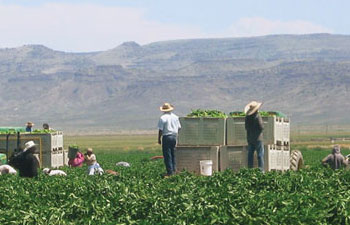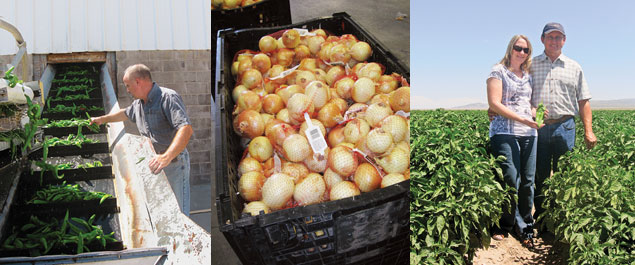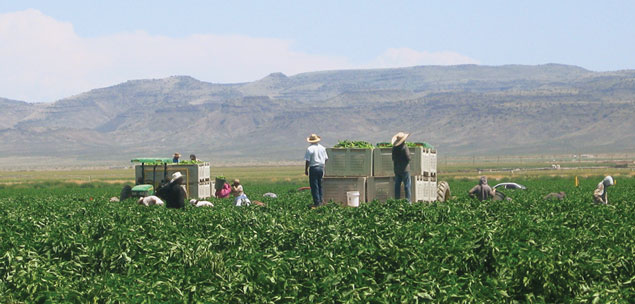
Scott Adams
Photo courtesy of Adams Produce Inc.
As a college student and dispatcher for a produce company in New Mexico’s Hatch Valley, Stormy Adams wanted to prove that with a few small changes he could better service the company’s local onion growers. He thought that with a business of his own, he would put a priority on charging the growers less money and getting products shipped and delivered to customers on time. It made for a strong business plan, but his desire for the new venture was also a little more personal — Stormy hailed from a family of onion farmers that includes his brother, Scott.
Today, the brothers’ relationship goes beyond family — it’s a symbiotic professional partnership that plays to their own individual talents and passions. Simply put, Scott’s company, Adams Produce, grows the onions, and Stormy’s company, Shiloh Produce, finds a market for them.
“I wanted to take care of the customer and take care of the grower and bring the two together so that they have a contract that works,” Stormy says of the initial plan for a new business.
Today, these Ag New Mexico customers are still doing just that, as they work hard in their respective roles to put market-fresh Hatch Valley onions in grocery stores and restaurants, and on the plates of consumers across the country.
Diversifying With Different Varieties and Different Farms
New Mexico is the No. 2 fresh-market onion-producing state, behind California, and more than half of the onions consumed in the United States during the summer months are grown in the state.
In the Hatch Valley, onions are planted in the fall, and because a single variety can have a seven- to 10-day harvest window, several varieties with various maturity dates must be grown. Not only does Scott diversify Adams Produce by planting several varieties, he also plants on several different farms in southern New Mexico to ensure that he can make a healthy crop. Factors such as elevation, soil type and even the temperature of the irrigation water all contribute to making each field a little different. At one farm, the water temperature is 25 degrees warmer than at other locations, making those onions mature faster.
Onion harvest begins in late May and typically continues through early August. While some late-planted varieties are harvested in September, they don’t comprise much of Scott’s crop because he also grows green chile that becomes ready for harvest the same month.
“There are days when the crew is picking green chile in the morning and onions in the afternoon, but we don’t like to do that a lot because it just stretches our crew out too much,” Scott explains.
Diversifying With Different Varieties and Different Farms
New Mexico is the No. 2 fresh-market onion-producing state, behind California, and more than half of the onions consumed in the United States during the summer months are grown in the state.
In the Hatch Valley, onions are planted in the fall, and because a single variety can have a seven- to 10-day harvest window, several varieties with various maturity dates must be grown. Not only does Scott diversify Adams Produce by planting several varieties, he also plants on several different farms in southern New Mexico to ensure that he can make a healthy crop. Factors such as elevation, soil type and even the temperature of the irrigation water all contribute to making each field a little different. At one farm, the water temperature is 25 degrees warmer than at other locations, making those onions mature faster.
Onion harvest begins in late May and typically continues through early August. While some late-planted varieties are harvested in September, they don’t comprise much of Scott’s crop because he also grows green chile that becomes ready for harvest the same month.
“There are days when the crew is picking green chile in the morning and onions in the afternoon, but we don’t like to do that a lot because it just stretches our crew out too much,” Scott explains.

Left: Dennis Alberson (above) and Stormy Adams own AA Chile Company, which includes a chile plant in Arrey, N.M. Right: Terry and Scott Adams
Photos by Sarah Harris
Harvesting onions requires a lot of equipment and a lot of people. Ideally beginning in the early morning hours, 150 workers will arrive to work in a field dotted with storage bins waiting to be filled with onions. As onions are pulled from the ground and placed in the bins, four forklifts are standing ready nearby to lift two to four full bins at a time onto semitrailers. Throughout the harvest, 45,000 to 50,000 full bins will be transported to the Adams Produce onion shed in Hatch.
“The harvest requires a lot of organization,” Scott states. In earlier years, the produce was collected in burlap gunny bags and left in the bags to age before it was transported to the shed for packaging — a method that Scott is glad has been improved and updated.
From the Ground to the Grocery Store in 10 Days
Once the onions are harvested and the bins are loaded onto semitrailers, they are taken to the onion shed. It takes 18 dryers three to seven days to cure the onions, depending on their moisture content. The drying causes the onions to form a hard skin, which makes dirt easier to remove and the produce hardier and less susceptible to damage.
The cured onions are then sorted and bagged. Adams Produce packages onions in 25-, 40- and 50-pound bulk sacks, but when these bags reach the market, the onions they contain are displayed and sold separately. Another of Stormy’s companies housed in the same shed, AA Chile, is responsible for packaging and distributing 2-, 3-, 4-, 5- and 10-pound bags of medium-sized onions, also known as consumer packs.
“We are trying to meet the needs of everyone involved,” Stormy declares. “It’s not an exact science where you say, ‘We’re going to pack a 50-pound sack of onions, and we’re going to sell that.‘”
When the company first started, Adams Produce was selling only 50-pound sacks of jumbo onions with their own label on them. Later, when AA Chile began packaging consumer packs, they only sold three varieties. Today, with each chain store or food service company wanting its own label, Stormy’s partner in AA Chile, Dennis Alberson, estimates that he has 6 million labels in inventory ready to be used on consumer packs and 40 different types of labels for bulk sacks.
Since they specialize in market-fresh onions, the Adamses don’t hold produce over in cold storage. They pride themselves on getting the produce shipped as quickly as possible, and Scott says that a market-fresh onion can go from the ground to the grocery store in as little as seven to 10 days.

Chile harvesting at one of Scott Adams’ farms
Photos by Sarah Harris
Onion-producing states in the northwest, such as Washington and Idaho, begin flooding the markets with their produce in September, so it makes better business sense for most New Mexico onions to enter the market no later than August. After that, Stormy says that their ability to ship onions north and to the Midwest declines, but that they can service the southeastern and southwestern states until late summer.
Shiloh Produce shipped out an average of 117 truckloads of onions daily this past summer — a solid number considering that June harvests across the state were down due to a hard freeze that hit in February.
Two Heads Are Better Than One
While each brother has his own critical role in making the relationship work, it’s their teamwork that makes it a success. Both put a strong emphasis on doing whatever is needed to service their respective ends of the contract.
The two are also quick to acknowledge each other’s strengths. Stormy credits Scott with taking the onion shed to a new level of production, while Scott matter-of-factly states that Stormy always knows exactly what buyers are looking for and aptly keeps his hand on the pulse of the market.
Another point of agreement is their choice in lenders — all three of the brothers’ complex agribusinesses are customers of Ag New Mexico.
“Scott and Stormy are a great example of how separate companies can work great together to help reach everyone’s separate goals. I don’t think either family would be as successful without each other,” says Warren Russell, the brothers’ Farm Credit loan officer. “They each do what they do best, as Scott is a great producer and Stormy is one of the best produce brokers in the U.S.”
Scott’s son, Tyson, has been growing crops alongside his dad for the past four years, and Stormy’s son Zack has been learning the ins and outs of marketing onions, as both young men plan to carry on their family businesses.
In addition, Stormy’s wife, Amby, and Scott’s wife, Terry, who handles bookkeeping and payroll duties, also have active roles in the companies. Terry recognizes that while increased demand over the years has changed her husband’s focus as a grower, it’s been advantageous in several ways.
“Buyers used to work with what growers had to sell, but we [as growers] are now working from a buyer’s point of view and planting crops to satisfy their needs,” Terry says. “It’s a plus that our broker is in the family.”
– Staff